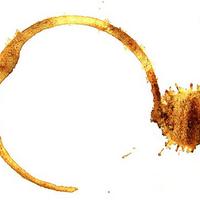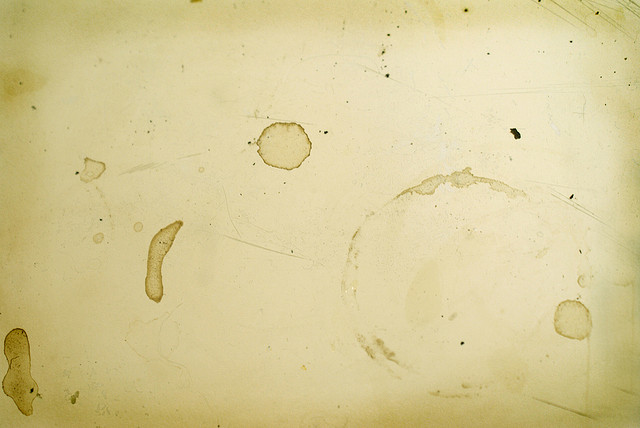
Oct 24, 2012
If you're someone who's into coffee, I'm guessing most of what you've read up on has to do with beans, sustainability, brewing ... but today I'm going to get a little more … physical. It’s a little-known story about the delicate dance of ... coffee rings.
Both David from New York and Becky from Los Angeles sent requests to our Cabinet of Curiosities for more insights into food. So here we go, with a foodie-factoid I find particularly fascinating.
Though the dust hasn't settled on the facts, reports have it that we've been drinking coffee if not since the days when goats started dancing in joy after eating the beans, then perhaps since waaaayyy back in the 6th century, when Yemeni legend has it that religious leader Sheikh Omar (disciple to Sheik Abou'l hasan Schadheli, the patron saint and supposed founder of Mocha, Yemen, a port also known for its coffee beans) used the boiled beans to sustain himself while in exile. As long as beans have been brewed, and cups have been sipped, and sloshed, they've created those distinctive splotches and circles we know so well: coffee rings. You know what I’m talking about -- those crusty, brown arcs, with the relatively clear centers that form beneath your coffee maker if you don’t get the canister underneath the drip, drip, drip in time. Or that sprout on your tabletop when a missed sip from your mug rolls down to the base of your cup and evaporates into a ring with solid, dark edges.

Photo by moofyboof/flickr/CC-BY-2.0
WHY do droplets of this brown drink dry in such a distinct manner? You may never have wondered about this, but guess what? Physicists have! Because it turns out coffee rings are really interesting little formations. Plenty of other liquids full of dissolved stuff don't behave this way. Drop a bit of detergent, and chances are it'll dry with all the particles spread evenly throughout the area that was once a puddle. The same with a muddy pool -- when it dries, you don't see the bits of mud all swept to the outer lip. But when you dissolve coffee grounds in water, then spill the suspension, a very physical rearrangement happens: the grounds go from being evenly dispersed throughout the liquid, to being clumped crustily on the edges when it dries. Scientists call this the “coffee ring effect” (though full disclosure, coffee isn't actually the only liquid to do the ring thing -- you’ll know from evening cocktails that red wine will do the same to your linoleum).
So what's going on here? Turns out, there's a ton of action inside that drop of liquid staining your newspaper. Here's what we know: the shape of the drop is like an over-turned bowl, fat in the center, sloping down to the edges. And because the edges are less packed with water molecules, the water out there evaporates more quickly. But here's the thing: when the drop hits a surface (whether it's a countertop or a page of your journal), that surface catches the rim of the droplet in a wrestler-like grasp -- the rim gets PINNED to the surface, and can't move. Ever. So as the water evaporates, escaping as a gas, the pinned drop can't shrink into itself. Instead, it flattens out -- keeping a constant width as it pushes water from the center out toward the stuck rim. And as the water is pushed toward the rim, it carries with it all those dissolved particles (coffee grinds!) ... which stay behind after the water evaporates. Voila! A ring is formed. Centuries of non-wondering wondering, solved!
But … why don't all drops act like this?
The shape of the particle dissolved in the water makes a difference. If a droplet has spherical particles (grounds in coffee, tannins in wine, even salt spread onto the sidewalk in winter), a ring will form; if the particle is lumpy, or oblong (think about ink in your inkjet printer), it'll spread out evenly, and those dark edges will not form. Spherical particles can slideeeeee past each other much easier than blocky ones, letting them fan out in pretty rings. Here's a funky, hypnotic, microscopic time-lapse of all this action:
It’s fascinating to me that something that looks so dull and brown is teeming with activity. And there are some very handy real-world benefits to understanding this effect -- this knowledge can be used to improve manufacturing techniques, for example, by helping make suspended liquids that spread the way you want them to (important for dyes, printing, chemical sprays). And even more exciting: a young team proposes that perhaps the coffee ring effect could become a useful medical diagnostic tool.
See, the thing is, the coffee ring on your countertop may be messy-looking, but it's not disorganized: different-sized particles actually arrange themselves in separate rings by size, with the smallest particles out nearer to the edge. The team suggests that maybe, just maybe, if we wanted to know what was in a liquid sample of water, blood or urine, we could drop a small drop, let it evaporate, and see what the rings say. For example, what if I wondered if you had the nasty E.coli bacteria in your blood? One of the teams' researchers, Tak Sing Wong, explained to me that E. coli is a very specific size (about one micron, for those interested). And so, chances are, if you drop a bit of E. coli contaminated blood and let it evaporate, you'll see rings of E. coli, separate from rings of red blood cells, or other molecular proteins, hidden in the liquid. Well then blammo! Just by looking, you'd know something was up. No electricity, no fancy dyes, no refrigeration required. Nothing like this has been done in the real world (and there are so many questions that would still need to be answered, about particles of the same size or different shapes, about the actual methodology, etc etc), but it's the potential, the potency, the-ordinary-thing-turned-on-its-head, that intrigues me. The fact that the smudge we've been swiping away for years is bristling with activity? Awesome! Activity we might harness? Dude, that's some powerful coffee. And some powerful physics.